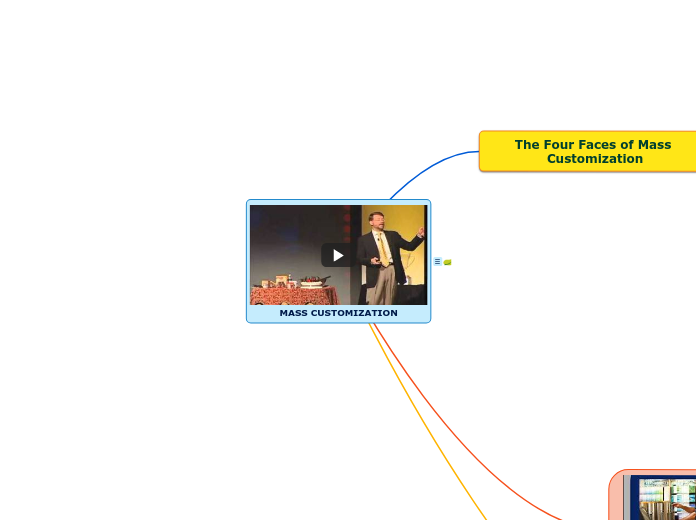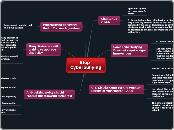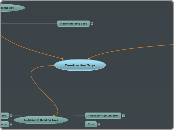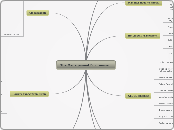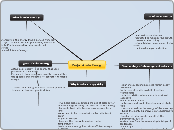MASS CUSTOMIZATION
Mass customization is a process that allows a customer to personalize certain features of a product while still keeping costs at or near mass production prices.
To be successful, Mass Customization requires three main elements as outlined by Paul Zipkin:
- Elicitation: Interacting with customers to collect information
- Flexibility: Manufacture the product according to the information
- Logistics: Processing stage and distribution able to maintain the product identity
Through the recent tech breakthrough, mass customization is currently achievable using various technologies to increase responsiveness, reduce costs, and increase the level of service. In this MindMap, we will be focusing specifically on:
- 3D printing
- IOT
- Smart Manufacturing
- AI
Examples of the impact of mass customization in different industries
Printing
Manufacturing
Food, Fashion & others
Mass Customization in Fashion
Postponement strategy
While the goal of mass customization is to produce customized goods at low costs, postponement strategy focuses on delaying customization as close to the customers as possible. Therefore it is also known as "delayed differentiation".
Postponement involves designing and developing standard or generic configurable products that can be customized quickly and inexpensively once actual consumer demand is known. Postponement also entails the implementation of specific inventory strategies to deploy inventory farther away from the customer while fulfilling service level objectives and reducing inventory costs and minimizing risks, i.e., strategies for holding the right inventory, at the right place, in the right form.
While many industries and companies are prime for postponement, there are certain business conditions that position a company for a more successful postponement implementation. Prominent among these are companies that produce a significant variety of products with short product life cycles and which have a supply chain able to support mass customization.
Take for example an umbrella manufacturer who does not know what the demand will be for different colored umbrellas. The manufacturer will manufacture all white umbrellas and dye them later when umbrellas are in season and it is easier to predict demand of each color of umbrella. This way the manufacturer can stock up on white umbrellas early with minimal labor costs, and be sure of the demand before they dedicate time and money into predicting the demand so far in the future.
Postponement can be an effective mass-customization tool for a company. The major advantages of exploiting postponement are:
- Inventory savings: Inventory is more at generic level – fewer variants of Stock Keeping Units and less safety stock requirements.
- Less risk of salvaging and obsolescence: No finished product inventories – prevent loss of high value added inventory and obsolete finished products.
- Better forecasting: Forecasting more generic and consolidated products – forecasting gets easier and has fewer errors.
- Greater flexibility and variety: Final customization is postponed until the confirmation of exact customer need and order – gives the ability to match the customer need without wasting previously added values to the product.
Example of postponement strategy at DELL
A good example of postponement strategy is Dell Computers' build-to-order online store. In this short video you can watch how Dell has mastered the art of postponement for their custom-designed machines for individual consumers.
In the personal computer (PC) market historically products were made-to-stock. PC's were assembled as a finished product, shipped to the store, and kept in inventory. What Michael Dell saw as an opportunity became a new model for the entire industry. Instead of assembling a complete PC, Dell created a supply chain where the company would hold inventory of component parts in a few centralized locations, and as customer's placed their orders, a Dell computer would be assembled exactly to the customer's requirements. Distribution and shipping is direct to the customer. This system allowed Dell to become more flexible in their supply chain, created efficiencies and reduced lead times. As many pre-assembled PC's were manufactured overseas, the lead time for shipping to the customer was 4-6 weeks. With the Dell model, a PC could be fully assembled in one to two days, and the customer would receive their order by the end of the week. This process alone significantly reduces the holding costs incurred during shipping as well as improving customer satisfaction. With this strategy of postponement, Dell commonly holds inventory for less than 4 days. By using a postponement assembly strategy, Dell is able to minimize their inventory, generate cash much faster and reinvest this cash into improving their supply chain model.
The Four Faces of Mass Customization
Transparent Customization
The transparent approach to customization is appropriate when customers’ specific needs are predictable or can easily be deduced, and especially when customers do not want to state their needs repeatedly. Transparent customizers observe customers’ behavior without direct interaction and then inconspicuously customize their offerings within a standard package.
Artificial Intelligence
Artificial intelligence (AI) makes it possible for machines to learn from experience, adjust to new inputs and perform human-like tasks.
The supply chains of the future will have many more echelons for manufacturing and distribution, their geographical spread will call for synchronization, and multiple outlets for sales run the risk of channel conflict. Artificial intelligence is needed not only for precision in forecasts but also for the optimization of countless processes, and the implementation of a cohesive strategy for sales. At each of these levels, organizational restructuring is needed to align it with the needs of digital technologies.
How IOT can save cost and enhance mass customization
Mass customization and AI-powered supply chains: Process acceleration and Uber models for resource allocation
AI and Data, the Future of Supply Chain Management
AI can change the core of marketing theory
Cosmetic Customization
The cosmetic approach is appropriate when customers use a product the same way and differ only in how they want it presented. Rather than being customized or customizable, the standard offering is packaged specially for each customer. For example, the product is displayed differently, its attributes and benefits are advertised in different ways, the customer’s name is placed on each item, or promotional programs are designed and communicated differently. Although personalizing a product in this way is, frankly, cosmetic, it is still of real value to many customers.
IoT
The Internet of things describes the network of physical objects—a.k.a. "things"—that are embedded with sensors, software, and other technologies for the purpose of connecting and exchanging data with other devices and systems over the Internet.
Mass customization requires considerate inventory management, highly flexible manufacturing operations and a transparent supply chain. IoT helps to increase efficiency at each stage. By fetching real-time data from sensors and/or RFID tags, IoT allows businesses to produce customized products in an efficient way, sparing excessive costs and keeping operations smooth and aligned.
IIoT and Mass Customization: How Do They Fit Together?
An Approach to Iot Service Optimal Composition for Mass Customization on Cloud Manufacturing
How Technology can drive the next wave of mass customization
Adaptive customization
The adaptive approach is appropriate for businesses whose customers want the product to perform in different ways on different occasions, and available technology makes it possible for them to customize the product easily on their own
3D Printing
3D Printing is a process for making a physical object from a three-dimensional digital model (CAD representation), typically by laying down many successive thin layers of a material.
3D printing processes allow for mass customisation, it offers the ability to personalize products according to individual needs and requirements, does not require physical moulds or specific tools, and can manufacture numerous products at the same time.
The technology offer a number of benefits:
- Responsiveness: Objects which traditionally take days to be created can be built in minutes or hours
- Cost: It provides great cost savings from the limited requirements to start production
- Customer Satisfaction: the ability to produce a perfect physical object from a digital file
It also has drawbacks:
- Energy consumption and heat of the system
- 3D printing can be more expensive the traditional manufacturing for important productions
- Health risks from the particles which could harm employees
- Job losses and replaced by this technology
- Speed - some manufacturing operation will be faster than 3D printers.
Subtopic
Why is 3D Printing best suited for mass-customization?
3D PRINTING AND THE FUTURE OF SUPPLY CHAINS
3D Printing and Mass Customization, Hand in Glove Part I
Collaborative Customization
The approach most often associated with the term mass customization, collaborative customization is appropriate for businesses whose customers cannot easily articulate what they want and grow frustrated when forced to select from a plethora of options.
Smart Factories
A smart factory is where physical production processes and operations are combined with digital technology, smart computing and big data to create a more opportunistic system for companies that focus on manufacturing and supply chain management.
Digital manufacturing provides on-demand parts to companies, creating agile product development at those companies and enabling them to offer much more personalized choices to their customers.
The idea that technology will move the consumer to the very centre of the production process rather than the end.
Material Handling
The digital manufacturing enterprise powers the customer life cycle
How Smart, Connected Products Are Transforming Competition
The Smart Factory: Exploring Adaptive and Flexible Manufacturing Solutions
